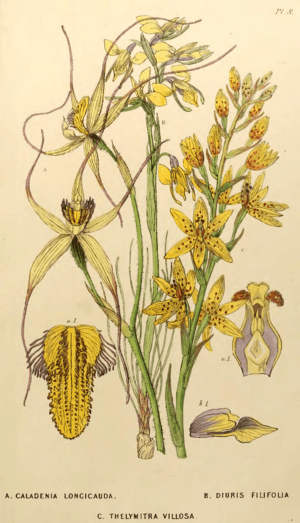Cat's face orchid facts for kids
Quick facts for kids Cat's face orchid |
|
|---|---|
 |
|
| Caladenia longicauda (A), Diuris filifolia (B) and Thelymitra villosa (C) from A Sketch of the Vegetation of the Swan River Colony. | |
| Scientific classification | |
| Genus: |
Diuris
|
| Species: |
filifolia
|
The Cat's face orchid (scientific name: Diuris filifolia) is a special type of orchid. It is found only in the south-west part of Western Australia. This orchid is quite rare. Sometimes, many of them bloom at once. This usually happens only after a hot summer fire.
What Does It Look Like?
The Cat's face orchid is a tuberous plant. This means it grows from a small, potato-like part underground. It is also a perennial herb. This means it lives for more than two years.
It can grow to be about 200–450 mm (8–20 in) tall. It has between six and thirteen thin leaves. Each leaf is about 50–120 mm (2–5 in) long and 1–3 mm (0.04–0.1 in) wide.
The Flowers
The orchid has between two and seven pale yellow flowers. They have reddish-brown markings. Each flower is about 20–25 mm (0.8–1 in) long and 20 mm (0.8 in) wide.
The top part of the flower, called the dorsal sepal, stands up. It is about 10–13 mm (0.4–0.5 in) long. The side sepals point downwards and forwards. They are about 12–16 mm (0.5–0.6 in) long.
The petals stand up or curve backwards. The main part of the petal is about 9–12 mm (0.4–0.5 in) long. The labellum is the special lip-like part of the orchid. It has three sections. The middle section is about 8–10 mm (0.3–0.4 in) long.
The Cat's face orchid blooms from October to November. A hot fire in the previous summer helps more flowers grow.
How It Got Its Name
The scientific name for this orchid is Diuris filifolia. It was first officially described in 1840. This was done by a person named John Lindley. The description was published in a book called A Sketch of the Vegetation of the Swan River Colony.
The second part of its name, filifolia, comes from two Latin words. Filum means "thread". Folium means "a leaf". This name refers to the thin, thread-like leaves at the bottom of the flower stem.
Where It Lives
The Cat's face orchid grows in sandy soil. It is often found near areas that get wet in winter. These areas are between York and Mount Barker. This region is known as the Swan Coastal Plain.
As mentioned, it is a rare Diuris orchid. It sometimes flowers in large numbers. But this only happens after hot fires in the previous summer.
Conservation Status
The Western Australian Government's Department of Parks and Wildlife has looked at the Cat's face orchid. They have classified it as "not threatened." This means it is not currently in danger of disappearing.

